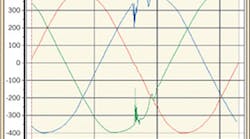All kinds of quick fixes exist for protecting motors from transients. But they address only one range of voltage [e.g., metal oxide varistors (MOVs) on the power supply], or they don’t actually do anything at all (e.g., ground rods connected to the motor), or they are in the wrong location (surge protectors only at the service) to provide real protection.
Most transients capable of damaging a motor are generated within the facility. So first address those sources. Those sources are typically other large motors that start across the line. Installing soft starters or variable frequency drives (VFDs) on all large motors will eliminate those motors as sources of damaging transients.
Although this is a costly proposition, it typically costs far less than the damage from transients. Soft starters and VFDs also extend the lives of motors, thus reducing expensive motor failures. To get corporate approval for soft starters or VFDs, you may need to use a power analyzer to capture the power events so you have actual data showing where the transients come from.
What else can you do? Instead of driving a ground rod, ensure the motor system is properly bonded per Art. 250, Part V. This will help in handling any transients that do occur.
Next, address transient protection. You need a progressive tier system that works its way down to the final point of use. At each tier, the energy level is lower than at the previous tier. Lightning protection around the building envelope is your first barrier; lightning is the highest voltage level (at the typical facility). Keep in mind that lightning can easily jump over the body of any surge protective device (SPD) and so can lightning-induced surges.
Your next barrier is an Art. 280 surge device (e.g., spark gap arrestor) installed ahead of the service connection. Then you proceed with Art. 280 and/or Art. 285 surge protection on the interior.
Which types of SPDs you choose and which ratings go where depends upon the energy levels you’re encountering at each level. So instead of slamming a power supply MOV with a 5,000V surge, you progressively tamp the voltage surge down (level by level in the distribution system) until by the time the transient reaches that MOV it’s within the rating of the device.




